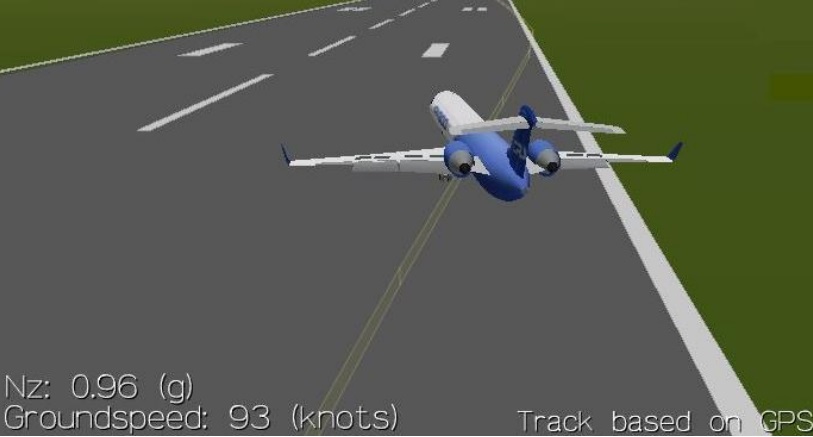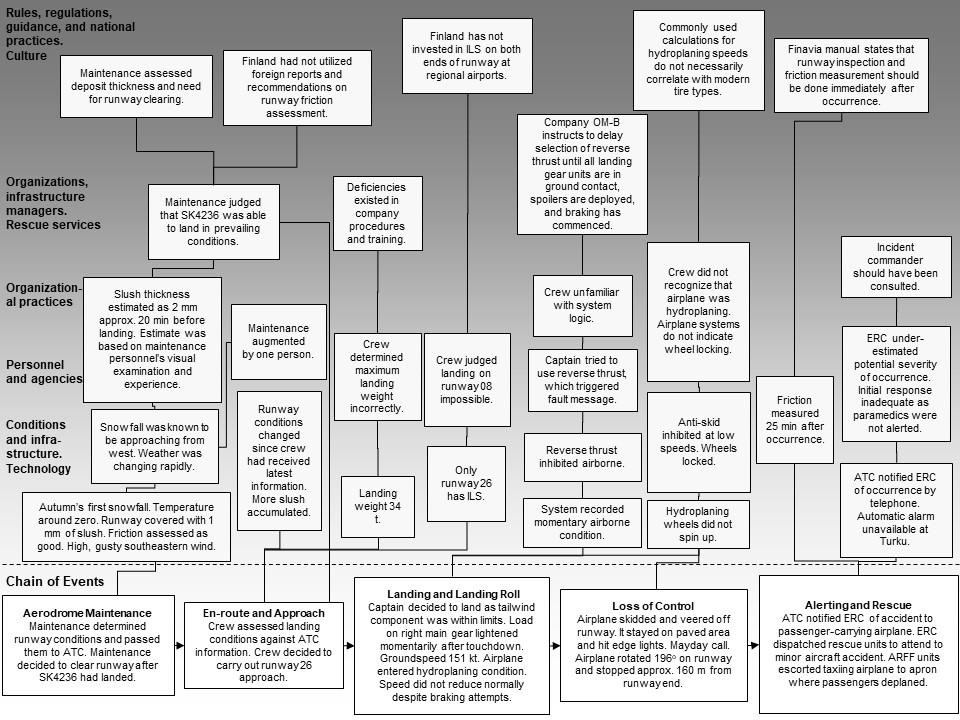CRJ900 Skids Sideways Down Finnish Runway
On 25 October 2017, Bombardier CRJ900 EI-FPD of Cityjet was operating as Scandinavian Airlines (SAS) flight SK4236 from Stockholm, Sweden, to Turku, Finland, where it landed at 2024 local time.
The Landing of Cityjet Bombardier CRJ900 EI-FPD at Turku
After touchdown the aircraft did not decelerate as anticipated and entered a skid, drifting towards the right hand edge of the runway but with the nose pointing to the left of track.
In their safety investigation report the Finnish Safety Investigation Authority (SIAF or Onnettomuustutkintakeskus) describe how:
Approximately 1,200 m from touchdown, the skidding airplane began to veer to the right towards the edge of the paved area. It impacted and broke five runway edge lights. The minimum distance between the right mainwheel tires and the unpaved area was less than 0.5 m. The airplane then started to rotate to the left. When it was at right angles to the runway heading it was moving at 42 kt (78 km/h) groundspeed. It came to a halt next to the runway centerline 2,050 m from the initial touchdown point, having rotated 196° counter-clockwise from the initial direction of travel.
The distance from the final position to the runway end was approximately 160 m.
Analysis
SIAF developed an AcciMap that summarises their analysis:
SIAF Conclusions
SIAF present 11 conclusions, each paired first with an observation:
1. Aerodrome maintenance decided to clear the runway after an arriving flight had landed and a departing flight had taken off. The decision was not reviewed even though weather was changing rapidly and continuous snowfall increased the thickness of the slush layer on the runway.
Conclusion: Long-term runway maintenance planning is not possible under rapidly changing weather conditions.
2. The flight crew did not question the weather and runway condition data on which they based their decisions. The flight crew monitored wind data closely.
Conclusion: Some time had passed from the preparation of the previous SNOWTAM. Personnel at the aerodrome knew that snowfall was intensifying. SNOWTAM reliability degrades fast under rapidly changing weather conditions.
3. The airplane was above the maximum performance limited landing weight on landing.
Conclusion: The multi-step procedure required to determine the permitted landing weight using the tables provided for the purpose contributed to an error in weight calculations.
4. At Turku, only runway 26 is ILS-equipped.
Conclusion: The flight crew elected to conduct a tailwind landing on runway 26 because they considered a runway 08 approach impossible due to the lack of ILS. Finland’s airports, with the exception of Helsinki-Vantaa, have ILS at one end of the runway only.
5. Landing was firm; therefore, weight on the right main landing gear lightened as the oleo leg extended after touchdown, the extension reaching a point where the airplane systems sensed an airborne condition. The thrust reverser system, although armed, was unavailable after touchdown.
Conclusion: The flight crew was not familiar with reselecting the thrust reverser system in case of it being inhibited.
6. The airplane entered a hydroplaning condition at the moment of touchdown due to the high groundspeed and a slush deposit on the runway.
Conclusion: Anticipating the possibility of hydroplaning enhances situational awareness and prepares for a necessary action if the airplane enters a
hydroplaning condition.
7. Hydroplaning prevented the wheels from spinning up to a required speed and therefore the anti-skid system did not activate. The captain’s brake application, which was later augmented by simultaneous brake application by the first officer, resulted in the wheels remaining locked until the airplane came to a halt.
Conclusion: The flight crew did not recognize a hydroplaning condition and the fact that the wheels were not rotating.
8. The equation used to determine hydroplaning and hydroplaning speeds was verified in tests in the 1960s. The values derived from the equation do not necessarily correlate with modern aircraft tires, which may enter a hydroplaning condition at lower speeds.
Conclusion: More knowledge, reports, and possibly research will be needed for the reliable determination of the hydroplaning speeds of modern aircraft tires.
9. Since aileron control was not applied throughout the landing roll, the airplane started to veer towards the right edge of the runway, pushed by the wind.
Conclusion: In the CRJ900, the application of aileron control is important in order to maintain airplane control during a crosswind landing.
10. The verification of the prevailing runway conditions began approximately 25 min after the occurrence. Since the conditions were changing due to the snowfall, the runway conditions at the time of the occurrence were, perforce, based on estimates.
Conclusion: It is essential for investigation purposes that the prevailing runway conditions are determined immediately after an occurrence.
11. The controller called the ERC [Emergency Response Centre], which alerted rescue units to respond to a minor aircraft accident. Paramedic units were not alerted, and the incident commander was not consulted about the matter.
Conclusion: When a controller makes an emergency call while simultaneously attending to other duties, the processing time will increase and the risk assessment at the ERC will be affected by uncertainties.
Safety Recommendations
SIAF made five safety recommendations:
- Finavia reviews the current methods for runway condition assessment, runway maintenance, and response to changing conditions, and on the basis of the review implements the necessary changes. [2018-S46]
- The Irish Aviation Authority (IAA) oversees that the methods used by CityJet for performance calculations are adequate and ensure safe operation under different circumstances. [2018-S47]
- Transport Canada (TC) oversees that Bombardier provides operators with information on the logic of thrust reverser system operation in various situations. [2018-S48]
- Transport Canada (TC), as the CRJ series airplane type approval authority, oversees that Bombardier demonstrates that hydroplaning speed are determined in a sufficiently reliable manner for the tire types currently used in airplanes. [2018-S49]
- The Ministry of Interior together with the Emergency Response Center Agency investigate ways of finding a modern technical solution that would facilitate quick forwarding of an alarm from an air traffic control facility to an ERC. [2018-S5]
Safety Resources
On error management:
…and our review of The Field Guide to Understanding Human Error by Sidney Dekker presented to the Royal Aeronautical Society (RAeS): The Field Guide to Understanding Human Error – A Review
- Runway Excursion Exposes Safety Management Issues
- G200 Leaves Runway in Abuja Due to “Improper” Handling
- AAIB: Human Factors and the Identification of Saab 2000 Flight Control Malfunctions
- Twin Otter Nose Wheel Steering Misused in Runway Excursion
- Procedural Drift at Saab 340 Operator Leads to Taxiway Excursion
- Gulfstream G-IV Take Off Accident & Human Factors
- Confusion of Compelling, But Erroneous, PC-12 Synthetic Vision Display
- C-130J Control Restriction Accident, Jalalabad
- Easyjet A320 Flap / Landing Gear Mis-selections
- Premature A319 Evacuation With Engines Running
- Gripen Main Landing Gear Damaged During Unstabalised Short Field Landing
- UPDATE 4 October 2020: Investigators Suggest Cultural Indifference to Checklist Use a Factor in TAROM ATR42 Runway Excursion




Recent Comments